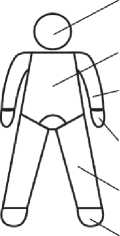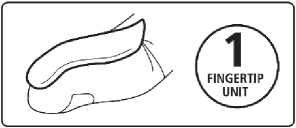Cutivate 0.05% W/W Cream
Leaflet code
Package Leaflet: Information for the User
Cutivate® 0.05% w/w Cream Fluticasone Propionate 0.05% w/w Cream
fluticasone propionate
Face and neck:
2 'h fingertip units, Back: 7 fingertip units. Front: 7 fingertip units.
One arm (not including the hand}:
3 fingertip units.
Both sides of one hand:
1 fingertip unit.
One leg (not including the foot):
6 fingertip units.
One foot:
2 fingertip units.

For a child
|
Number of fingertip units needed | |||||
|
Child’s age |
Face and neck |
Arm and hand |
Leg and foot |
Front |
Back including buttocks |
|
3-6 months |
1 |
1 |
1 / |
1 |
1 / |
|
1-2 years |
1 / |
1 / |
2 |
2 |
3 |
|
3-5 years |
1 / |
2 |
3 |
3 |
3 / |
|
6-10 years |
2 |
2 / |
4 / |
3 / |
5 |
The name of your medicine is Cutivate 0.05% w/w Cream or Fluticasone Propionate 0.05% w/w Cream. It will be referred to as Cutivate throughout the remainder of this leaflet.
Read all of this leaflet carefully before you start using this medicine because it contains important information for you.
• Keep this leaflet. You may need to read it again.
• If you have any further questions, ask your doctor or pharmacist.
• This medicine has been prescribed for you only. Do not pass it on to others. It may harm them, even if their signs of illness are the same as yours.
• If you get any side effects, talk to your doctor or pharmacist. This includes any possible side effects not listed in this leaflet. See section 4.
What is in this leaflet:
1 What Cutivate is and what it is used for
2 What you need to knew before you use Cutivate
3 How to use Cutivate
4 Possible side effects
5 How to store Cutivate
6 Contents of the pack and other Information
1 What Cutivate is and what it is used for
Cutivate contains a medicine called ftuticasone propionate. It belongs to a group of medicines called steroids. It helps to reduce swelling and irritation.
Cutivate is used to help reduce the redness and itchiness of certain skin problems.
• For adults these skin problems include eczema, psoriasis, dermatitis, insect bites or 'prickly heat'.
• For infants and children it is used for dermatitis that has not responded to milder steroid creams or ointments, following doctors advice.
2 What you need to know before you use Cutivate
Do not use Cutivate:
• if you are allergic to fluticasone propionate or any of the other ingredients of this medicine (listed in Section 6)
• on an infant under 3 months
• to treat any of the following skin problems, it could make them worse:
- acne
- severe flushing of skin on and around your nose (rosacea)
- spotty red rash around your mouth (perioral dermatitis)
- itching around your back passage or private parts
- infected skin (unless the infection is being treated with an anti-infective medicine at the same time).
- itchy skin which is not inflamed Do not use if any of the above apply to you. If you are not sure, talk to your doctor or pharmacist before using Cutivate.
Warnings and precautions
Talk to your doctor or pharmacist before using Cutivate if:
• you have previously had an allergic reaction with another steroid
• you are applying the cream under an airtiqht dressing, including a child's nappy. These dressings make it easier for the active ingredient to pass through the skin. It is possible to accidentally end up using too much cream.
• you have psoriasis, your doctor will want to see you more often.
If you are not sure if the above apply to you, talk to your doctor or pharmacist before using this medicine.
Other medicines and Cutivate
Tell your doctor or pharmacist if you are taking, have recently taken or might take any other medicine, especially if you are taking ritonavir and itraconazole medications.
Pregnancy, breast-feeding and
fertility
If you are pregnant or breast-feeding, think you may be pregnant or are planning to have a baby, ask your doctor or pharmacist for advice before taking this medicine.
Cutivate Cream contains imidurea, cetostearyl alcohol and propylene glycol
Cutivate cream contains an ingredient called imidurea. Your body can break down imidurea in to small amounts of a chemical called formaldehyde. This chemical may cause a skin reaction, including redness and itchiness.
Cutivate cream also contains cetostearyl alcohol which may cause local skin reactions (e.g. local dermatitis) and propylene glycol which may cause local skin irritation.
3 How to use Cutivate
Always use this medicine exactly as your doctor has told you. Check with your doctor or pharmacist if you are not sure.
Using this medicine
• Apply a thin layer of Cutivate up to
2 times a day. This may be reduced as your skin begins to get better.
• This cream is for use on your skin only.
• Do not use on large areas of the body for a long time (such as every day for many weeks or months) - unless your doctor tells you to.
• The germs that cause infections like warm and moist conditions under dressings so always clean the skin before a fresh dressing is put on.
• If you are applying the cream on someone else make sure you wash your hands after use or wear disposable plastic gloves.
• If your skin problem does not improve, talk to your doctor.
Guidance on how to apply the cream
1 Wash your hands.
2 Apply a thin layer to the affected area(s) and gently rub into the skin until it has all disappeared. You can measure how much Cutivate to use with your fingertip. For children you will need to use less cream but still use an adult finger to measure out the fingertip unit. This picture shows one fingertip unit.

3 Unless you are meant to apply the cream to your hands as a part of the treatment, wash them again after using the cream.
For an adult
Do not worry if you find you need a little more or less than this. It is only a rough guide.
• Do not use it on infants under 3 months of age.
• A doctor will provide expert advice on treating your child's skin problem.
• If the child's skin problem does not improve in 7 to 14 days, talk to your doctor.
• It should not be used every day for more than 4 weeks.
If you apply Cutivate to your face
You should only apply the cream to your face if your doctor tells you to. The cream should not be used for too long as the skin on your face thins easily.
Do not let the cream get into your eyes.
If you use more Cutivate than you should
If, by mistake on a few occasions you use more than you should, do not worry. If you apply a lot or if a lot is accidentally swallowed, it could make you ill. Talk to your doctor or go to hospital as soon as possible.
If you forget to use Cutivate
If you forget to apply your cream, apply it as soon as you remember. If it is close to the time you are next meant to apply it, wait until this time.
If you stop using Cutivate
If you use Cutivate regularly make sure you talk to your doctor before you stop using it.
If you have any further questions on the use of this medicine, ask your doctor or pharmacist.
4 Possible side effects
Like all medicines, this medicine can cause side effects, atthough not everybody gets them.
Stop using Cutivate and tell your doctor as soon as possible if:
• you find that your skin problem gets worse or becomes swollen during treatment. You may be allergic to the cream, have an infection or need other treatment.
Other side effects you may notice when using Cutivate include:
Common (may affect up to 1 in 10 people)
• Irritation or itching.
Uncommon (may affect up to 1 in 100 people)
• A feeling of burning where the cream is applied.
Very rare (may affect up to 1 in
10.000 people)
• If you have psoriasis you may get raised bumps with pus under the skin. This can happen during or after the treatment and is known as pustular psoriasis.
• An infection may be caused under airtight dressings or skin folds.
Side effects if you use Cutivate for a long time, or you use a lot each time you apply it, or you apply it under an airtight dressing or a nappy:
Very rare (may affect up to 1 in
10.000 people)
• Stretch marks may develop.
• Veins under the surface of your skin may become more noticeable.
• Increased hair growth and loss of skin colour.
• Thinning of your skin that may also damage more easily.
• Weight gain, rounding of the face and high blood pressure. These are more likely to happen in infants and children.
Reporting of side effects
If you get any side effects, talk to your doctor, pharmacist or nurse. This includes any possible side effects not listed in this leaflet. You can also report side effects directly via the Yellow Card Scheme at:
www.mhra.gov.uk/yellowcard By reporting side effects you can help provide more information on the safety of this medicine.
Manufacturer:
Glaxo Operations UK Limited (trading as Glaxo Wellcome Operations)
Harmire Road Barnard Castle Co. Durham DL128DT UK
Procured from within the EU.
Repackaged by:
Dr. Fisher Farma B.V.,
Vijzelweg 32 8243 PM Lelystad
The Netherlands
Product Licence Holder:
Medixl Ltd Maple House High Street Potters Bar EN65BS UK
PL 46245/0014 Cutivate 0.05% w/w Cream Fluticasone Propionate 0.05% w/w Cream
|POM|
This leaflet was last revised on 3rd October 2016
Cutivate® is a trademark of Glaxo Group Ltd
5 How to store Cutivate
• Keep out of the sight and reach of children.
• Do not use this medicine after the expiry date which is stated on the tube or carton after Exp. The expiry date refers to the last day of that month.
• Do not store above 30°C.
• Do not freeze.
• Do not throwaway medicines via wastewater or household waste.
Ask your pharmacist how to throw away medicines you no longer use. These measures will help to protect the environment.
• If you notice any signs of discolouration or deterioration of your medicine, please tell your pharmacist immediately.
6 Contents of the pack and other information
What Cutivate contains
• The active ingredient is fluticasone propionate. Each 1 g of cream contains 0.5 mg of fluticasone propionate (0.05% w/w).
• The other ingredients are liquid paraffin, cetostearyl alcohol, isopropyl myristate, cetomacrogol 1000, propylene glycol, imidurea, sodium phosphate, citric acid monohydrate and purified water.
What Cutivate looks like and contents of the pack
Each carton contains a tube with a plastic screw cap. The tube contains 30 g of white, smooth cream.